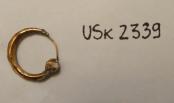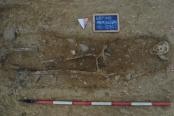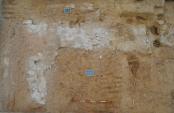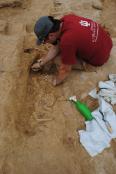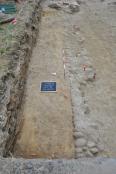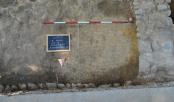CAMPAGNA 2013 |
1° SETTIMANA |
2° SETTIMANA |
3° SETTIMANA |
4° SETTIMANA |
5° SETTIMANA |
6° SETTIMANA |
7° SETTIMANA |
8° SETTIMANA |
18 LUGLIO 2013 
Resoconto della giornata di scavo
Area 1000
Nella giornata di oggi è stato completato lo scavo della sepoltura USk 1206, nel settore C, di cui è rimasta traccia di parte dei due arti inferiori e solo l'ombra del cranio. Questi elementi sono sufficienti a darci informazioni riguardo l'orientamento dell'inumato, in senso ovest-est, che coincide con quello delle sepolture medievali individuate nella stessa porzione dell'area. Si è proceduto quindi con una pulizia generale dell'area che ha permesso di individuare numerose chiazze scure con frammenti di laterizi e di lastre litiche all'interno, di cui si devono chiarire i perimetri e che fanno pensare a riempimenti di buche forse relative a fasi di restauro della chiesa. Nei prossimi giorni metteremo in evidenza gli eventuali tagli per poter comprenderne la funzione e soprattutto la fase cronologica di appartenenza.
Today we continued working in different sections in the area in order to find more context that can lead us to clues about history of the abbey. Kailey Anabel & David continued working in the test pit. They got rid of the rest of the fill. In the late morning they removed the femora. In the afternoon they completed the stratigraphic context sheets for the fill and the cut as well as a human bone sheet for the femora that were found. They finished the day by pick axing to remove a layer and will continue with that tomorrow.
Sophie, Diana, and Stephanie thoroughly dusted the westernmost part of the area in the morning. In the early afternoon the section was wet down to more easily see the differences in color over the area. Six or seven fills are easily visible and will be investigated in the future.
Megan continued with the trench along the eastern wall. She reached the bottom and found the walls of the trench perfectly.
We are starting to look at the area as a whole. We are learning about how all the trenches, holes, and other cuts relate chronologically to each other.
Area 2000
Al termine della rimozione dello scheletro USk 2339 nel Settore B, è stato documentato il letto di calce US 2338, su cui questo si adagiava, che ricopre omogeneamente il fondo della fossa US-2272; quest’azione ha permesso il rinvenimento di un orecchino d’oro a livello del cranio perfettamente conservato grazie all’azione della calce. Al di sotto compaiono alcune ossa lunghe in connessione, nello specifico due tibie e parzialmente i due femori, orientate W/E che proseguono con molta probabilità al di sotto di USM 2106; una prima ipotesi è che queste facciano riferimento a sepolture più antiche probabilmente di epoca medievale. Nel Settore A è stato rimosso il riempimento (US 2345) della fossa sepolcrale US-2344 identificata nella porzione centro occidentale del settore: questa è visibile solo per la metà più orientale in quanto prosegue al di sotto del limite ovest dell’area. All’interno è stato parzialmente individuato USk 2346 il quale risulta malamente preservato.
E’ stata inoltre verificata la presenza di una riduzione (US 2347) collocata al di sopra delle tibie di USk 2340 in US -2330 nella porzione più centrale: questa è composta da un cranio, un radio ed un’ulna, parte del bacino, alcune vertebre. Dopo la documentazione si è proceduto con l’evidenziare le ossa in connessione dello scheletro in posizione primaria che sarà entro la giornata di domana completamente messo in luce e rimosso.
In Section B, burial 2339 was removed while removing lime layer 2338. In that lime fill, an earring was found.While cleaning the lime, 2 long bones oriented east-west were found going through the cut.This was then cleaned and recorded by taking photos.
In Section A, the northeast corner was cleaned and the connection for the brick wall was found.Cleaning continued to find a cut, and scattered bone fragments were found.
In US 2244, fill was removed.A few mandibles and long bones were found along with assorted teeth.A cranium was also found, which may be part of an articulated skeleton.
Also in Section A, the reduction US 2247 was found, explored, cleaned, documented with photographs, and the limit was identified.While working to remove the reduction, a number of bones were found in fragments, including half of a cranium, fragments of ribs and tibias, and an intact radius.Once the reduction was cleared, we continued to remove the fill 2331 and exposed most of the bones for the skeleton underneath, USK 2340.
The northwest corner of Section A was cleared again and cut 2345 was explored.A partially exposed skeleton (cut in half by the nearby wall at the edge of the area) was revealed and cleaned. A photo and GIS points will be taken tomorrow.
Area 3000
Nel Settore A è stata conclusa la messa in luce dell’individuo medievale Us 3290, orientato W-E e deposto in decubito dorsale all’interno della fossa sepolcrale US – 3291, nella porzione N-E del settore. Lo scheletro, mal preservato, risulta privo di entrambi gli omeri (eccetto parte dell’epifisi prossimale del destro), di gran parte del torace (eccetto alcune coste dell’emitorace destro), l’avambraccio destro ed il piede dello stesso lato. Il cranio, in apparizione frontale, si presenta molto frammentato; l’arto superiore sinistro è disteso lungo il corpo, mentre la posizione della mano destra sul pube ci suggerisce che quello destro doveva essere leggermente flesso sul bacino. Gli arti inferiori sono invece simmetrici e distesi. In prossimità del parietale destro del cranio è stato rinvenuto un chiodo, che potrebbe indicare la presenza originaria di una cassa lignea, ormai decomposta; si evidenzia inoltre una verticalizzazione delle clavicole ed una generale compressione laterale dell’arto superiore sinistro e della pelvi, causata probabilmente da un sudario, che non si è preservato. Nel Settore B continua lo scavo della trincea US – 3257, che probabilmente attraversa tutta la porzione Nord del Settore B, tagliando parte del muro USM 3073, continuando ad Ovest nel Settore A, fino a congiungersi con l’accumulo di pietre rinvenuto lungo la sezione occidentale della fossa rettangolare US – 3220. Nella porzione occidentale del settore la pulizia dell’ampliamento ha permesso di individuare alcuni tagli di fosse sepolcrali, orientati N-S, che saranno indagati nei giorni seguenti.
The northern portion of the extended sector A was levelled approximately 5 cm and the northern portion of the wall was cleaned.
At 3258, the trench was extended westward; it runs along the wall. There were smooth stones and bricks which continue to line the floor.
In section A burial 3275, was continued to be cleaned and the remains removed. The context sheet and skeletal sheets were filled out according to procedure. The skeletal remains were partially removed. The skull and vertebral column remain, and will be removed tomorrow.
At 3090 the wall south was followed to see if it is continuous. It is not. Pickaxing of 3111 which is west of the wall was begun this afternoon. Levelling continued and an articulated tibia and femur were located.
Cleaning of skeleton 3233 was completed, the skeletal context sheet was filled, and the skeleton photographed. It will be removed tomorrow.
Sector A skeleton 3290 was cleaned entirely and photographs were taken. Took total station points of the burial and specific elevations of bones. Filled out skeletal context sheet and began to remove skeleton. Removed both tibiae and fibulae, femurs and pelvis. Also recovered both hands and the left arm up to the articulation with the humerus. Removal of the rest of this skeleton is to be completed tomorrow. This burial appears to be wrapped in a shroud due to linear delimitation to the left arm, hand and femur being in the same line. The position of this particular hand is congruent with being held in-situ during decomposition by an external shroud.
Area 4000
Settore A – Saggio 4800
Nell’approfondimento sono state rimosse US 4803, US 4804, US 4805 ed US 4806, i riempimenti dei tagli US -4807, US -4808, US -4809 ed US 4810; attività dalle forme subircolari con andamenti Sud- Nord ed Est-Ovest. Queste rimozioni hanno permesso di mettere in luce una nuova situazione nell’angolo occidentale del saggio : un taglio con orientamento nord-sud (US -4812) a sua volta intercettato dalle due attività US -4815 ed US -4813 (tagli sub circolari con andamento est-ovest). Iniziata la rimozione del riempimento di US -4815 (US 4816) è stata subito notata la presenza di ossa lunghe in connessione (relative agli arti inferiori) con continuazione in direzione Ovest, oltre il limite del saggio. Alla luce di questo fatto si è deciso di estendere ulteriormente il limite occidentale dell’approfondimento, dunque con le indagini successive sarà possibile mettere in luce quella che sembra una sepoltura cronologicamente anteriore alla posa della struttura medievale US 4062.
Settore A – Saggio 4900
Nell’angolo nord orientale del settore, a ridosso del lato destro della struttura US 4062, si è deciso di aprire un ulteriore saggio di approfondimento che includa, nella sua estensione, la suddetta struttura e la sua omologa perpendicolare US 4123. La decisione è stata presa per indagare i rapporti stratigrafici e cronologici fra i due muri del chiostro che, insieme, formano l’angolo nord-occidentale del giardino interno. Ad ora, dopo l’iniziale rimozione di US 4901 (=US 4116) è stato individuato un nuovo strato, US 4902, contesto argilloso di colore marrone scuro presente nell’angolo nord occidentale del saggio, a ridosso dell’angolo delle strutture interessate.
Settore B
Lo spazio compreso fra la struttura (orientate est-ovest) US 4123 e la sezione Nord dell’area è stato definitivamente messo in luce ed identificato con US 4133 (strato argilloso di colore marrone chiaro, molto compatto). Dovrebbe trattarsi del deposito soprastante lo spazio del chiostro identificato con il corridoio nord, aggettante sul giardino interno.
Settore C
Una volta rimosso lo strato cementizio US 4128 è stato messo in luce un nuovo piano livellato caratterizzato dalla presenza di laterizi inclusi in malta (US 4132), sempre relativo a fasi di vita post-moderne del sito. Tale insieme sembra poggiare direttamente sullo strato composto da lastre di ardesia (US 4130) risultante dal livellamento di un precedente strato di crollo. Un ulteriore allargamento del settore è stato eseguito verso est, permettendo di individuare la cresta di una nuova struttura dello stesso allineamento e foggia di US 4131, il muro che, insieme ad US 4123 dovrebbe disegnare l’angolo nord orientale del giardino del chiostro. la distanza fra la suddetta US 4131 e la nuova struttura individuata risulta essere di 3,60 mt c.a.; identica a quella presente fra (dal lato opposto dell’area, nel Settore A) US 4062 ed US 4126 (lacerto di struttura probabilmente espoliata in epoca moderna). Posizione, dimensioni, parallelismi di queste situazioni, permettono di ipotizzare la presenza delle due ale con andamento Nord-Sud del corridoio del chiostro : la Est e la Ovest; separate centralmente (13 mt) da un giardino interno e collegate (a Nord ed a Sud) da altri due corridoi ad esse ortogonali (il Nord, relativo ad US 4123, ed il Sud, ipotizzato in un’area ancora da indagare).
Today at site 4000, in section 4133, we cleaned and photographed what is believed to be the hallway of the northern wall of the cloister. Then, section 4132 was removed to expose the inner hallway of the eastern wall of the cloister and the outer eastern wall of the cloister. In section B of 4000, a new test pit, 4900, was started to find a connection between the northern and western walls. This test pit was then cleaned and pictures were taken for documentation. Lower limb leg bones were found in the test pit in section A and as a result, the test pit was expanded to expose the upper half of a possible burial connecting to the lower limb bones found.









